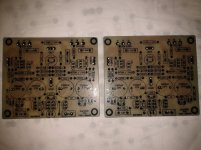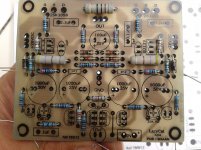Thankyou,
yes it's silver coated. all peeceebe process have done manually.
i enjoy all processing step. it's Do it Myself 🙂.



dear shan,
p[lz also share me with the copper side of this peeceebee.
yours ever masood
Layout link :- Post 3048
Schematic link:- Post 3056
dear shan ,
i have 2 pair of mosfet 2sk1058 and 2sj162.so i want to use them in single hi-fi amplifier do you have such type of amplifier circuit and pcb detail plz send me if you not mention .sorry to bother you.
thanks masood
You can use them in parallel in SSA without any special modification to the amp. IMHO the VAS should drive even 4 pairs 2sk/2sj with ease.
No, i use electro-less coating process.Are you doing actual silver nitrate bath electroplating?
lucky me, i source locally and i found ready to use solution. no need to mixing of chemicals.I saw one DIYer silver coating his pcb in You Tube , it looks complicated though mixing these 3 types of chemicals, it looks like a chemist job 🙁
Naf, what is this immersion silver you mentioned, can this product be purchased locally? I have read silver nitrate is very expensive.
Yo naf.
I can hardly wait to see the complete board with parts soldered. 😉 😀 🙂
Me too and some LEDs shining on.

LC and Shaan thankyou for your support,
I'll complete the board and lit the LEDs 😀...and post here my progress.
This is my first CFB and FET Amp... lucky me (again) i found this thread 😉.. and meet both of you guys.
I'll complete the board and lit the LEDs 😀...and post here my progress.
This is my first CFB and FET Amp... lucky me (again) i found this thread 😉.. and meet both of you guys.
This is my first CFB and FET Amp...
OHHH? Nice, very nice. Sonic surprises are waiting for you.
Lucky me (again) i found this thread 😉
Yeah me too.
But would you listen my funny story with SSA? Go back to posts of September of last year, and you will see SSA was pure tragedy for me. I ended up with a hum generator and possibly an oscillating RF transmitter.

I gave up.
But...
The sound I heard from my speakers with that fail-built SSA was something I couldn't achieve with any of my later amplifiers.
Confused, I gathered a lot of courage and calmed my mind and attempted the SSA again in July this year. I was determined to make it work. I went through ALL the SSA thread and found hidden treasure like information which helped me build the amp successfully in FIRST attempt. The day I started soldering was they day I was listening to music, with NO hint of any of the problems that attacked me last year. Happy ever after.

Confused, I gathered a lot of courage and calmed my mind
I rarely failed in building amplifiers. But when it happens, it is strange, I always throw away the stuff, bury it somewhere and don't want to see it again.
Now I remember I have 3 modules with expensive parts somewhere. I even have one complete amp with a very good casing and a very good transformer (every layer of winding is separated by paper), but I don't remember where they are now 😀
Just to insist on the fact that ceramic caps are mechanically resonant (A little like Quartz), and, so not so good on the signal paths. Better avoid them and use other technology (film).Initially installed a 5.6pF ceramic their. Treble okay.
Then I placed a 10pF ceramic. Treble okay.
Then placed 100pF/2KV. Treble okay.
Now it's 22pF. Treble okay.
470pF? Don't know.
edit: No audible RF modulation noise in any of the above cases, even with my standing-wave RF exciter turned on.
About the value of the Cr cap. (To answer to AndrewT ), It present no advantages (Phase response) to reduce the bandwidth of an amp by oversizing compensation cap, OMHO.
Just try to compensate with the littlest value for a flat HF response curve, Loudspeakers connected. Of course, make sure the amp is stable with no oscillation.
Test this both with real Loudspeakers cables ended by a resistance as a charge at full modulation signals, ans real loudspeakers with small signals.
Then, look at the square waves, and compensate any overshoot tuning input low pass filter cap.
My two cents.
That was fast shaan😀
The size of the board is still to big when viewed. Even when I select View - actual size.😕
The size of the board is still to big when viewed. Even when I select View - actual size.😕
Last edited:
That was fast shaan😀
The size of the board is still to big when viewed. Even when I select View - actual size.😕
This is because my PCB software does not output pdf and I had to use online image-to-pdf converter.
I think you can scale the material to custom size in the print options. Also, inserting the png in an A4 page in word processor like MS Word will allow scaling the image to exactly 3.5x3 inch while keeping the sharpness intact.
Hi Cambe, try this, i use this to toner transfer my board
Attachments
Last edited:
Hi Cambe.
I checked the PDF posted by naf. This will work. Recommended.
Hi naf, what software do you use to make these PDFs?
thanks.
I checked the PDF posted by naf. This will work. Recommended.
Hi naf, what software do you use to make these PDFs?
thanks.
Hi Cambe.
I checked the PDF posted by naf. This will work. Recommended.
Hi naf, what software do you use to make these PDFs?
thanks.
i use faststone image viewer, setting it to correct size 3.5 x 3 inch and print it to pdf using pdf factory.
And here may final board.. just to make building this beautiful Amp more easier for rookie builder like me 🙂
tomorrow i'll source all part and start to build.
wish me luck.
thanks
Attachments
Hi naf. Many thanks for info on faststone and pdffactory; small apps and very easy to use. Life is going to be easier from now on. 

OMG, i miss 1k2 in my material list ..  .
.
ok i'll series 1k + 220r resistor. Dear Shaan/LazyCat is this ok with this series resistor?
btw here my progress.
thanks
 .
. ok i'll series 1k + 220r resistor. Dear Shaan/LazyCat is this ok with this series resistor?
btw here my progress.
thanks
Attachments
Last edited:
OMG, i miss 1k2 in my material list ...
ok i'll series 1k + 220r resistor. Dear Shaan/LazyCat is this ok with this series resistor?
btw here my progress.
thanks
Yes 1K+220 is perfectly OKAY(I am doing this too). In fact, you may need to modify these values after checking the initial bias, which may not be optimum at first.
Board looking good with parts.

- Status
- Not open for further replies.
- Home
- Amplifiers
- Solid State
- Simple Symetrical Amplifier


